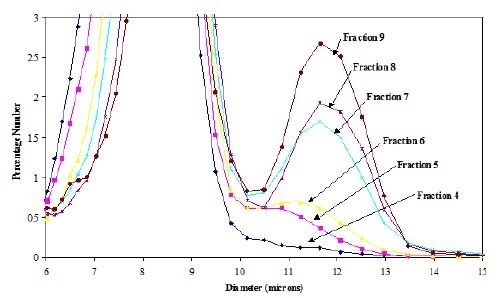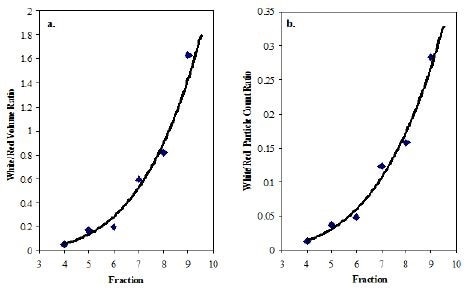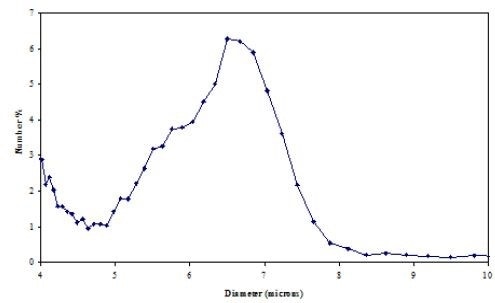To count white and red blood cells, the method traditionally used is the electrozone sensing technique. This method measures the increase in resistance, or in other words, the decrease in conductivity along a tiny aperture when particles suspended in a conductive medium pass through this aperture. The magnitude of this response varies in proportion to the size and volume of the particles.
This article discusses the particle counting ability of the Single Particle Optical Sensing (SPOS) technique featuring autodilution, which is capable of sizing both white and red blood cells efficiently with less diluent limitations in comparison with electrozone sensing. The AccuSizer 780 uses the principle of light obscuration or SPOS technique for individual particle counting and sizing.
The AccuSizer 780
In the AccuSizer 780, individual particles pass through the sensor and into a laser beam, and the light is subsequently blocked. A detector then detects the decrease in the light intensity, which varies in proportion to the cross-sectional area of the particles. The autodilution module performs automated sample dilution when the probability of more than one particle passing through the sensing zone is high.
Short Introduction to the AccuSizer SIS System
The attending fluidics has been designed to dilute the particles and pass them into the sensing zone at a particular rate. As a result, many particles can be counted within a short time interval (500,000 particles/minute) without any coincidence effects.
This helps achieve a true particle size distribution (PSD), meaning one particle at a time with very high statistical accuracy. A simple calibration curve can be used to convert pulse height into diameter, without using complex mathematical algorithms.
Thanks to the autodilution capabilities, only one particle is allowed to be present at a time in the sensing zone. Consequently, all particles passed into the sensing zone can be counted only once and in entirety.
Using such measurements, high resolution PSDs can be directly determined or the tail of coarse particles can be observed when PSDs are predominately below 1µm. This means both PSD data as well as quantitative count information can be obtained using the AccuSizer 780.
Analysis with AccuSizer 780 featuring Autodilution module
The AccuSizer 780 eliminates the problems experienced when using the electro sensing technique. It is optically based, and thus, allows the use of any suitable diluents. This capability is important for the blood separation device, where different buffered solutions are needed to obtain different degrees of isolation. The presence of other ions prevents achieving the desired separation.
The size of the flow cell used in the AccuSizer 780 is larger than that of the white and red blood cells and therefore, the chance for clogging is slim and flow rates up to 120cc/minute can be achieved. Such high flow rates facilitate autodilution of the samples prior to analysis since dilution is important for accurate blood cell counting owing to the fact that the separator provides highly concentrated blood fractions.
For this analysis, blood cell fractions were prepared that were predominant in white blood cells to fractions predominant in red blood cells.
In this experiment, six fractions (Fraction 4 through to Fraction 9) were analyzed. Zeta potential measurements revealed that the Fraction 4 consisted of almost entirely red blood cells, followed by Fraction 5 through to Fraction 9 with an increasing proportion of white blood cells.
The PSDs measured by the AccuSizer 780 for each fraction are presented in Figure 1. Two narrow peaks are observed in the PSDs for all other fractions other than Fraction 4. The second peak shows an increase in count from nearly zero in Fraction 4 to progressively higher counts in each subsequent fraction, indicating an increase in white blood cell content in each subsequent fraction.

Figure 1. Comparison of various fractions of blood.
Graphs of the ratio of white blood cells to red blood cells plotted in different ways are shown in Figure 2. The ratio of the particle volume in peak 2 to peak 1 is shown in Figure 2a, while the ratio of the particles counted in peak 2 to peak 1 is shown in Figure 2b.
These results highlight the capability of the blood separation device to obtain the desired separation of the white and red blood cells. Also, the capability of the AccuSizer 780 to deliver quantitative measurement of the relative amounts of white versus red blood cells in a single measurement is also demonstrated.

Figure 2.a. Volume ratio of white and red blood cells versus blood fraction; b. Count ratio of white and red blood cells versus blood fraction.
In the electrozone method, the red blood cells must be lyzed to accurately determine the white blood cell count because of the possibility of obtaining inaccurate results due to the effect of the sheer number of red blood cells on the counting process.
The PSD obtained from lyzing fraction 6 prior to the measurement is shown in Figure 3. The particle count in Figure 3 represents the residual white blood cells whose size reduced upon lyzing. In peak 2, the actual number of counts before lyzing is close to the counts determined in the lyzing runs.

Figure 3. PSD of Fraction 6 after red blood cells were lyzed.
Conclusion
From the analysis results, it is evident that the SPOS technique can automatically count white and red blood cells using the autodilution module of the AccuSizer 780. Also, the SPOS technique is capable of performing quantitative analysis of white and red blood cells without the need for lyzing the red blood cells.
About Entegris
For over 35 years, Entegris has been committed to helping customers find solutions to their particle sizing problems. We offer products with unique capabilities that can size particles from single digit nanoparticles to particles that are thousands of microns in diameter. Whether you need a particle size distribution or to find that needle in a hay stack, our team of engineers and sales staff are available to provide the product knowledge and scientific expertise necessary to solve your sizing issues.
Sponsored Content Policy: News-Medical.net publishes articles and related content that may be derived from sources where we have existing commercial relationships, provided such content adds value to the core editorial ethos of News-Medical.Net which is to educate and iform site visitors interested in medical research, science, medical devices and treatments.